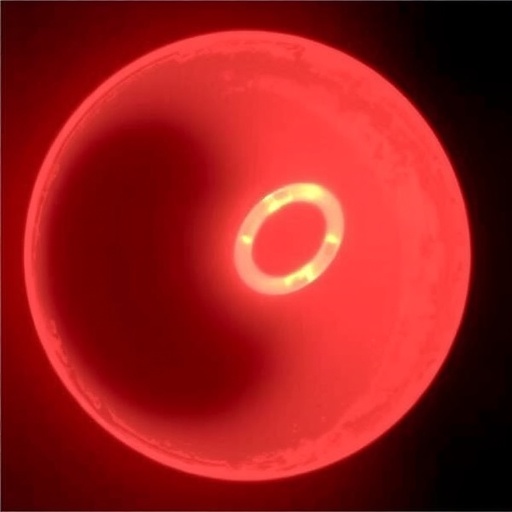The field of reproductive biology continues to evolve rapidly, with new insights into the mechanisms that govern oocyte development and fertilization. Recent research by Wu et al. sheds light on the intricate dynamics of smooth endoplasmic reticulum (SER) aggregates in oocytes, specifically focusing on the differences between progestin-primed and GnRH antagonist in vitro fertilization (IVF) protocols. This groundbreaking study not only enhances our understanding of oocyte maturation but also has significant implications for improving IVF outcomes, thereby rekindling hope for many who struggle with fertility.
The smooth endoplasmic reticulum plays an essential role in the oocyte’s capacity to support fertilization and subsequent embryonic development. It is intricately involved in lipid metabolism, calcium storage, and intracellular signaling pathways. The presence and functionality of SER in oocytes have long been recognized as critical factors influencing reproductive success. However, the exact implications of SER aggregates and their dynamics during different IVF protocols remained largely unexplored until now.
In this study, the authors meticulously compared the effects of two widely-used IVF protocols: the progestin-primed regimen and the GnRH antagonist protocol. While both methods are designed to optimize ovarian response and enhance the chances of successful fertilization, the impact of these contrasting approaches on oocyte quality and SER aggregates is profound. Prior research has suggested that hormonal environments profoundly influence oocyte maturation, yet this paper goes a step further, delving into the cellular constituents underpinning these processes.
The use of progestin in IVF protocols has gained traction due to its ability to create a favorable uterine environment. In their findings, Wu et al. noted that progestin-primed oocytes exhibited distinctive SER aggregation patterns. These aggregates appeared to contribute to enhanced lipid metabolism, which is vital for the energy needs of developing embryos. This understanding provides valuable context for practitioners in reproductive medicine, as it suggests that optimizing lipid storage within oocytes could lead to better developmental outcomes.
Conversely, the GnRH antagonist protocol, often favored for its flexibility and convenience, showed a different SER profile. Oocytes retrieved from this method displayed fewer and less organized SER aggregates. This finding raises questions about the mechanistic underpinnings of oocyte quality and how hormonal manipulations can directly affect the cellular architecture within these gametes. The implications of these differences are far-reaching, suggesting that protocol selection could be more than a matter of personal preference but rather a significant factor impacting the oocyte’s inherent potential.
Publications focusing on the cellular and molecular biology of oocytes have increasingly emphasized the importance of endoplasmic reticulum dynamics, but Wu et al.’s work brings this to the forefront of clinical considerations. The meticulous approach they employed, which included advanced imaging techniques and biochemical analyses, allowed for a comprehensive exploration of SER involvement in oocyte maturation under different hormonal stimuli. This shines light on the potential for targeted interventions aimed at manipulating SER aggregates to improve IVF outcomes.
Beyond the immediate applications in reproductive technology, these findings paint a broader picture of how relatively subtle changes in hormonal environments might indeed sculpt gametic health. The research fosters a deeper understanding of the symbiotic relationship between hormones and cellular structures within oocytes. It raises the question of whether fine-tuning hormone therapy could yield beneficial effects not only in oocyte quality but in overall reproductive health.
Moreover, the implications of these findings extend into future research avenues. As scientists aim to unravel the complex interactions between hormonal protocols and oocyte biology, attention shifts to how external stresses—such as environmental factors and lifestyle choices—may further influence SER dynamics. This presents an exciting frontier for reproductive biologists, offering new directions for research that could lead to revolutionary practices in assisted reproductive technology.
Crucially, the work of Wu et al. highlights the need for a more personalized approach to fertility treatments. By embracing the nuances of individual responses to hormonal therapies, practitioners can hone in on strategies that take into account the specific cellular behaviors and conditions of oocytes. This paradigm shift could pave the way for more tailored IVF protocols, improving success rates while reducing the emotional and physical burden on patients.
While the study undeniably advances our understanding of oocyte biology, it also calls for continued inquiry into the interplay of hormones, cellular structures, and the larger reproductive environment. As the conversation around fertility expands to encompass these intricate relationships, it becomes increasingly clear that understanding the fundamental science behind gamete quality will be pivotal in shaping the future of reproductive health.
In conclusion, Wu et al.’s exploration of smooth endoplasmic reticulum aggregates in oocytes offers both a snapshot of current knowledge and a roadmap for future investigations. As we move forward, it is imperative that both the scientific community and fertility practitioners embrace the findings of this research, leveraging them to enhance clinical practices and improve outcomes for aspiring parents. The quest for understanding the cellular mechanisms driving fertility is far from over, and it is through such insightful studies that we will continue to unlock the potential of assisted reproductive technologies.
In the coming years, it will be fascinating to observe how these insights are implemented in clinical settings and what further innovations emerge from a deeper understanding of oocyte biology. As our grasp of these cellular processes expands, the implications for reproductive medicine could be transformative, ushering in a new era of personalized and effective fertility treatments grounded in robust scientific understanding.
Subject of Research: The dynamics of smooth endoplasmic reticulum aggregates in oocytes during different IVF protocols.
Article Title: Smooth endoplasmic reticulum aggregates in oocytes: a comparison of progestin-primed and GnRH antagonist IVF protocols.
Article References:
Wu, HM., Weng, C.H., Sung, YJ. et al. Smooth endoplasmic reticulum aggregates in oocytes: a comparison of progestin-primed and GnRH antagonist IVF protocols.
J Ovarian Res 18, 181 (2025). https://doi.org/10.1186/s13048-025-01768-2
Image Credits: AI Generated
DOI: 10.1186/s13048-025-01768-2
Keywords: smooth endoplasmic reticulum, oocytes, IVF protocols, progestin-primed, GnRH antagonist, reproductive biology, fertility treatments.




